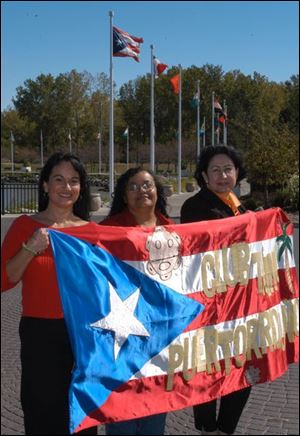
Local Puerto Ricans raising their profile
10/4/2004
Carmen Vega, Gladys Flores, and Maria Gonzalez hold their club flag in front of the Puerto Rican flag that flies atop a 20-foot pole at International Park.
The Puerto Rican flag flew over International Park for the first time in July as Club Taino Puertorriqueno celebrated the territory's adoption of its constitution. The hoisting of the flag marked the end of a seven-year effort to include it with other international banners at the riverside park.
Club members said that they hope the flag is just one step to greater awareness of Toledo's Puerto Rican community.
Most Hispanics in Northwest Ohio are of Mexican heritage - as much as 85 percent according to some statistics. Those of Puerto Rican heritage make up about 10 percent of the country's Hispanic population.
"The Puerto Rican flag is very much a symbol of pride," said Carmen Vega, a financial assistant with Advocates for Basic Legal Services and an officer in Club Taino. "Once a Puerto Rican sees the flag, they know that other Puerto Ricans are around. We are a part of the community here, and it's a diverse community. We are contributing it."
The island of Puerto Rico sits about 1,000 miles southeast of the mainland United States, east of Haiti and the Dominican Republic. Puerto Rico became a possession of the United States after the Spanish-American War in 1898. It's been a commonwealth of the United States since 1952.
The Taino Indians were the island's native inhabitants before Christopher Columbus landed there during his second voyage to the New World. Spain conquered the island in the early 1500s and brought African slaves. According to the Web site WelcomeToPuertoRico.org, 80.5 percent of the island's racial population is identified as white and eight percent black. Thomas Klak, a professor in the geography department at Miami University in Oxford, Ohio, said over the years the three main ethnicities have mingled.
"You would find very few people today who would call themselves Tainos or claim just African heritage. I think there is harmony between the ethnic groups pretty much because they have melded together," Mr. Klak said.
Salsa music originated from the Puerto Rican community in New York, influenced by Cuban and Afro-Caribbean sounds, according to WelcomeToPuertoRico.org. Dishes like Arroz con pollo (chicken and rice) and adoho and sofrito spice blends are also strongly connected to Puerto Rico, the Web site said.
Sonia Troche moved to Toledo to become executive director of Adelante Inc., a Latino drug treatment and advocacy agency, earlier this year. She worked as a senior community officer for the Puerto Rico Federal Affairs Administration in Cleveland before joining the South Toledo agency.
"In my personal view, there is a sense of connection in Puerto Rico with the U.S.," said Ms. Troche, who shuttled between Cleveland and Puerto Rico while growing up. "Even though we can't vote for the President, we follow things and feel a part. That changes, though, when you come to America.
"You start to see the difference in being a Latino and being Caucasian. You start to feel the language barrier and the discrimination. Many people don't know that Puerto Ricans are American citizens."
Mr. Klak said Puerto Ricans living in the states have a strong connection with the island and its history, partly because the ease of movement between the island and the states.
"Much of their identity [as Puerto Ricans] is having a foot in both regions," Mr. Klak said. "They are part of the United States, but not fully. They are part of Latin America, but not fully. They are kind of a bridge society between the two, but not completely in either."
Maria Gonzalez, owner of Azteca Travel, moved to Toledo in 1984 so her daughters could get specialized heart treatments at the Medical College of Ohio. Ms. Gonzalez, who managed a travel agency in Puerto Rico, said she found a job and new home here.
"I took a year's leave from my job [in Puerto Rico], and they're still waiting for me," she said with a laugh. "Toledo has been very good to me."
Ms. Gonzalez, president of Club Taino, said with the help of a local charity, her daughters - now grown - were able to get the treatment they needed. She started Azteca in 1989 because she saw a need to serve the Hispanic community, and has worked for herself ever since.
Ms. Gonzalez says the club has identified about 600 Puerto Ricans living in Lucas County. "We're anxious about the club teaching people more about the Puerto Rican community. We have our picnic every July and we hope one day that will become as big as the Greek-American Festival and a lot of the other festivals here."
Ms. Troche said the port of entry of many Puerto Ricans in Ohio was the Cleveland suburb of Lorain. Steel mills and manufacturing companies there recruited in New York and Puerto Rico and brought the first wave of island immigrants to the state. The results of that effort remain evident today.
Puerto Ricans make up the largest Hispanic group in Cleveland, Ms. Troche said. And Census figures show that Puerto Ricans make up nearly 20 percent of Lorain's overall population, making their presence larger than the African-American population there.
Ms. Vega said the club plans on creating a scholarship fund for students and hopes to build a center where citizens can find out more about Puerto Rico, its heritage, and the local community.
"We would like to have something similar to the Sophia Quintero [Cultural Center in South Toledo]," Ms. Vega said.
For now, people can see the Puerto Rican flag at International Park and know that the community it represents is alive and well in Toledo.
Contact Clyde Hughes at: chughes@theblade.com or 419-724-6095.